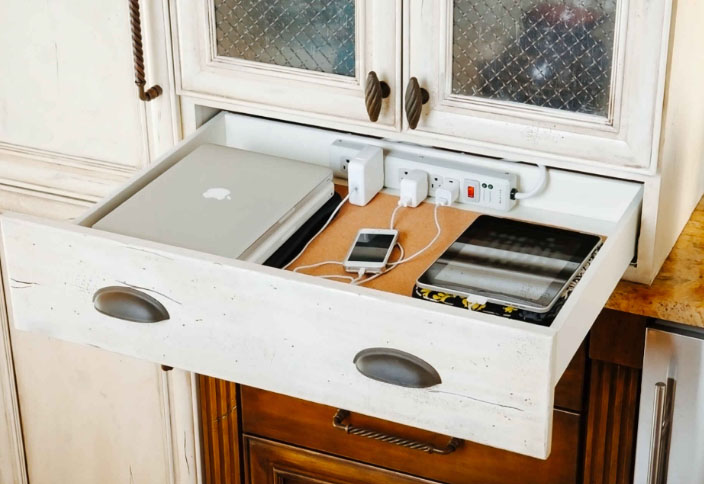How many outlets should be in the kitchen - the rules of safety and convenience
Power supply of residential premises - a vital question for the people, living in it. When installing electrical kitchen units need to strike a balance between the need to connect the greatest number of devices and safety during operation mounted power. In order to properly place the outlet in the apartment, it is necessary to pay attention to the load calculation based on the materials used and the applicable standards. How many outlets you need in the kitchen and at what height they need to arrange for convenience.

Sockets in the kitchen: the correct location and the optimum amount of
The kitchen in the apartment - it is energy-intensive premises. If the owner decides to hold the wiring in an apartment with his hands, he should first study the regulations, regulating the number and order of distribution outlets in the kitchen and switches.
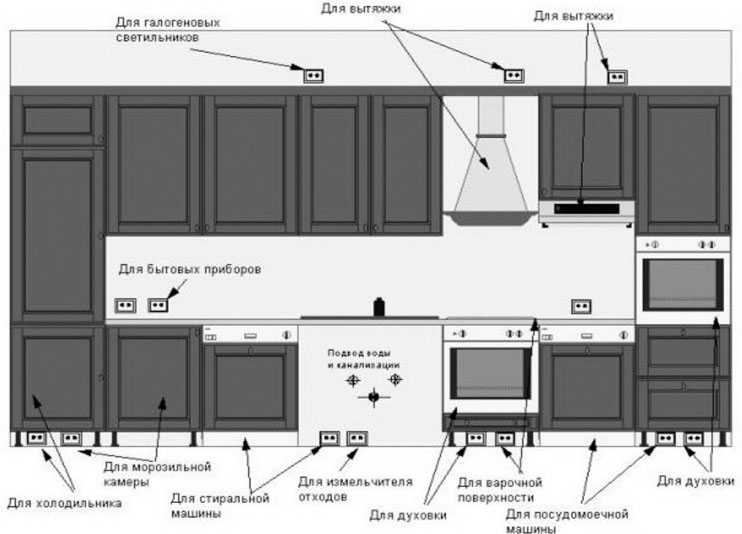
On this issue, in Russia there are such documents today, as:
- GUEST 7396.1-89, which determines the order of the installation locations of electrical connection;
- GUEST 8594-80, standards containing assembly boxes for switches and receptacles;
- SNIP 3.05.06-85. This is a collection of technical requirements for the calculation of allowable energonagruzki and the number of outlets, allowed to install.
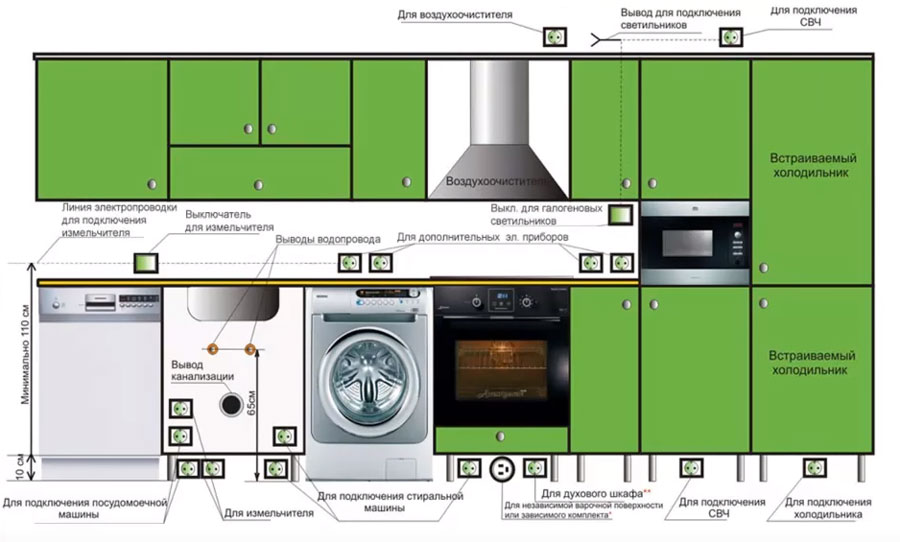
At what height from the floor doing outlet?
Given the ease of placement instruments and the frequency of operation of kitchen appliances, formed special rules for placement of outlets. Their height has three levels of accommodation.
- height from the floor outlets in the kitchen 10-15 cm for electric cookers, the refrigerator, dishwasher. Appropriate and practical. Installing kitchen furniture, access to outlets left only from below. And the wires will not hang on the walls, and will be aesthetically hidden away.
- installation height of sockets on the kitchen floor 110-130 cm: instruments to enable the blender, microwave, kettle.
- 200-250 cm - height of sockets for lighting and hoods. They are available and at the same time hidden behind the kitchen cabinets on top. Equally important in the distribution of outlets is necessary number. There is a golden rule - for every fixed kitchen appliances one socket, plus two blocks on the edges of countertops and another standing place near the dining table.
After studying the theory and regulations, the master must calculate the electrical wiring. This question, which determines the performance of devices and circuitry, disposable in the room. Besides, it is a question of fire safety. The correct calculation would not allow short circuit and fire of the connection. For this to be done correctly, You need to determine in advance the number of outlets in the kitchen.
The height of the table top
Then of course a matter of taste and beauty and comfort are no certain rules. With outlets to be comfortable to work, install power supply stands at a height of more 15 cm. from the upper edge countertops. Experts do not recommend to put the socket in this area is too high above the surface, since the apron - the place, which immediately catches the eye. A large number of protruding constantly included consumers will not make your interior better.
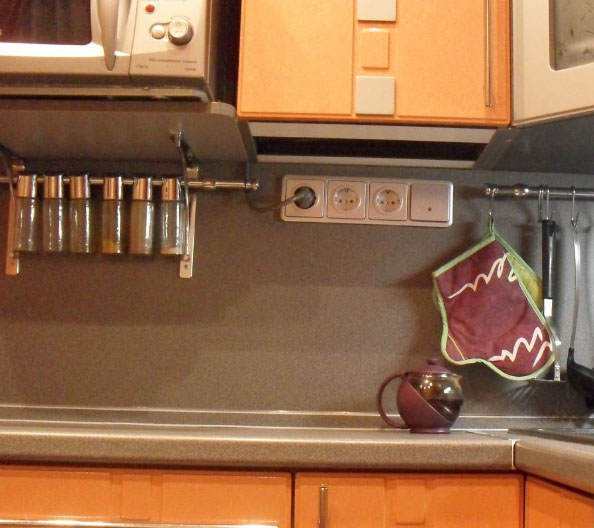
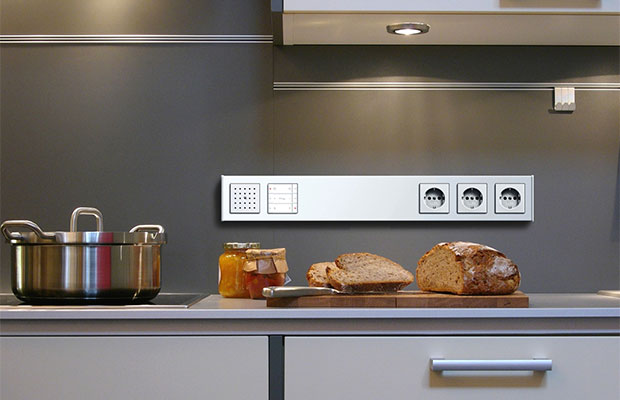
Mounting height standards
Now do the wiring to European standards, this is due to an increase in new housing. According to these rules, the installation of sockets, their height shall be 30 cm from the floor, and switch - 90 cm.This is due to the ease of use by all members of the family electrical appliances. Convenient for living rooms.
When the distribution of consumers in the kitchen should be planned such moments, the height of the outlet from the floor in the kitchen, taking into account the design of the premises. Otherwise, these devices simply can not be in the wrong place, where they are needed, namely for shelves. The position and height of the wall outlets from the floor in the kitchen also take into consideration the size of the kitchen furniture, length and height of the room.
To avoid mistakes in the calculations, should sketch plan kitchen on the sheet, and after the transfer the project to the kitchen wall socket and set in the right places, not forgetting the rules of the RCD.
Distance from countertop, to the outlet should be at least 10-15 cm, so they can hide, the instruments and not to disturb the overall picture of the kitchen. They can place, on the basis of expediency. Still, there are certain requirements, said electrical device in Regulation. they read as follows, that switches and sockets must be of the cab door opening at a distance of soul 60 See more, also from the shell. As well as the distance to the pipeline to be more 50 cm. These are mandatory requirements for fire safety rules, they need to follow unquestioningly, even if you have to change a little kitchen design.
Electrical power consumption
Before you plan the number and height of the outlet from the floor in the kitchen, will have to work on a blueprint of energy consumption. so, Below is a list of electrical appliances, which will be used in the kitchen, their power:
- lighting - 150-200 Watt.
- microwave - 2000 Watt.
- Fridge - 100 Watt.
- Dishwasher - 1000-2000 W.
- Electric kettle - 2000 Watt.
- Oven - 2000 Watt.
- water heater - 2000 Watt.
- Dishwasher - 3500-7500 W.
Special connections require the following devices:
- Dishwasher;
- Washer;
- hob;
- Water heater;
- oven.
The maximum load on the network is based on the work of electric cookers, oven and water heater.
Average connection is suitable for the microwave, kettle, Food Processor, the refrigerator, grinder and a toaster. At the same time the most power consuming dishwasher and washing machine, electric kettle, microwave.
While all of these devices will not be included in the network simultaneously, sufficiently high load. Consequently, average power ranges 10-15 kW, usually, power from the current collectors 7 kW, during normal operation, and alternate devices in the home. If this figure is higher, it makes sense to display 380 The wiring and distributing it in phases when such a possibility.
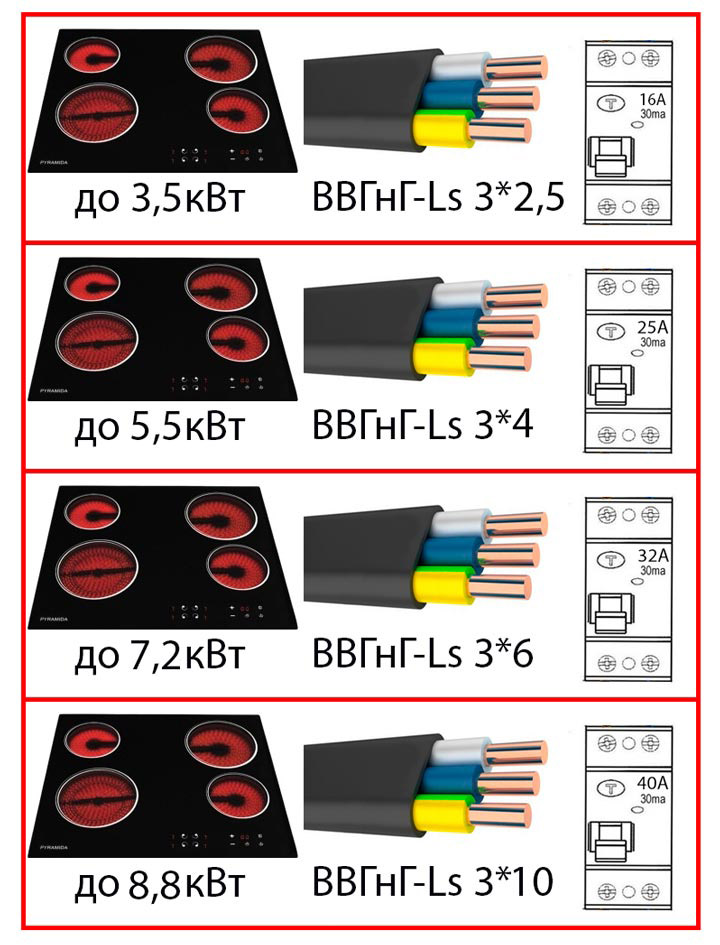
To determine the number of connection points is necessary at the stage of the kitchen design project to compile a list of mandatory units, appliances and lighting devices, which will be powered by such a connection to the network device.
Depending on the design of kitchen furniture and its location in the room chosen location of single outlets or with devices to connect multiple devices.
Properly install the outlet height helps norms and standards. This is done in accordance with the arrangement of furniture and kitchen units, to tables or cabinets do not interfere with their use.
Depending on the material from which the walls are made and method device field wiring to connect electrical appliances can be:
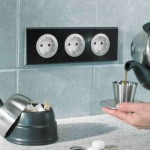
- embedded in the wall, Such devices are used mainly in the apartments of the panel or brick houses;
- overhead flush and patch for open wiring. Most often they are used in wooden construction or laying retroprovodki on insulators.
Modern regulations require, to the outlet equipped with a grounding.
Each socket is selected by type, necessary at this point.
- A single device with open holes for the plugs.
- Panel of two, three or four outlets with open holes.
- Single unit and panel with hidden openings. They can be a rotating bar, shutters or special cap. Do such a connection point for, so that small children can not accidentally there anything stick. Receptacle with a lid selected, if you want to place it near water. In this case, fit the model to the degree of protection IP54. It gives confidence, that water does not get to the source of electric current.
![the original outlet in the kitchen]()
- A device for switching should be selected for each device separately. All of them are designed for a certain amperage. If the instructions specified current for the device 10 — 16 ampere, the outlet is required to put on 16 ampere, and not 10.
The calculation of the optimum height of sockets: from the floor and over the worktop
Properly install the outlet the kitchen can be, See Pre this room into three zones - the lower, the middle and upper. Depending on the separation of the inclusions in the zones will depend on the height of their installation on the walls.
- The lower zone. This part should be positioned to connect places most power-consuming units are used in the kitchen. These include - refrigerator and freezer (in some cases, there may be several. It depends on the size of the kitchen premises and the owners needs.). In addition - a washing machine and dishwasher.
In this zone should be equipped with connection plate or hob, in that case, if the house is not connected to the gas. For these units may need three-phase sockets and plugs.
There you need to mount the device is connected to the oven (one or two), and filter and crushers, installed in the system from the sink.
in total, obtained, that in the lower region should be set at least five - six for the electrical connection device. Cable outlets in this zone should be calculated based on the projected energy consumption. On this line it is absolutely necessary to mount the circuit breaker. Fitting height from the floor to the bottom zone should be at least ten and not more than fifteen centimeters.

- The middle zone. This is a level surface for connecting working appliances, enjoyed by the owners in the kitchen. This is a standard set of, which includes - Kettle, coffee maker and coffee grinder, juicer, grinder and blender, and, multivarka, parovarka, elektrohlebopechka. There are other devices.
In this area the necessary instruments enough. In determining the number of connection devices for the installation of wiring required by the rule. One socket can not be enabled at the same time two devices, which have a total of more power, than nominal in this socket.
Therefore, the number of connection points should be more than thirty percent, what may be required under normal circumstances. Always a situation may arise, when it will be necessary to include the maximum number of home appliances.
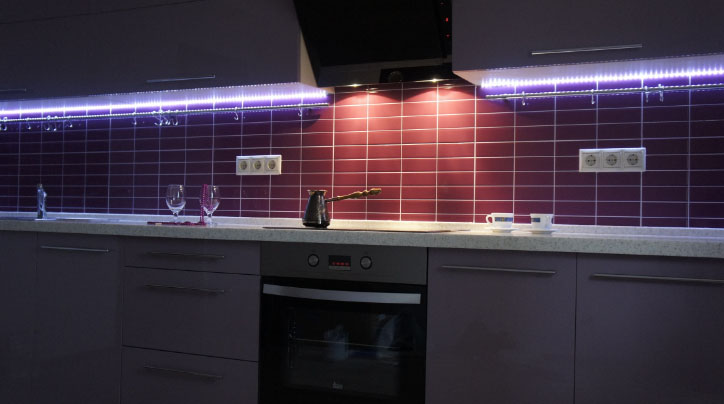
Can socket set on the countertop in the kitchen. The variant of the installation of connection points on the kitchen apron. In this case, the height should not be less than one meter. It is correct mounting devices for connecting ten centimeters above the surface of kitchen furniture. Socket for countertop should be built, so that moisture from the working surface could not get to the wire.
Rosette for a microwave oven is mounted near the instrument, to connect the cable is not hanging outside. The socket for the TV on the wall can be treated as a medium, and the upper zone. This will depend on the height of its location.
- Outer zone. At the level of ten centimeters from the ceiling and 5 — 6 centimeters from the upper surfaces of wall cabinets installed connection devices for drawing, mechanical ventilation (it is absolutely necessary, If the kitchen has gas appliances), lighting fixtures and electric water heater.

installation (installation) sockets: built-in countertop, Drawer, corner, overhead
Determination of the amount to be placed in the kitchen electrical connection points is an important moment in the stage of planning the electrical circuit in the room. This must be done, to know which wire need to start. How to connect one wire outlets. How long will it breakers and sockets which the nominal power must be taken.
Making a hole and a channel for the wires
According to the prepared wiring on the walls are marked places for installation locations of electrical connection.
At these points,, with special bits for concrete are made for the winding of the cable holes and placing the outlet box.
These holes are laid method shtrobleniya channels for routing wires from the main power cable, setting the kitchen.
If the outlet is planned in a kitchen worktop, Stroebe the channels according to plan the placement of furniture in these places.
Fastening block carton and
Installing electrical outlets starts with installation Escutcheon, after connection to the place to be held by a broken wire channels.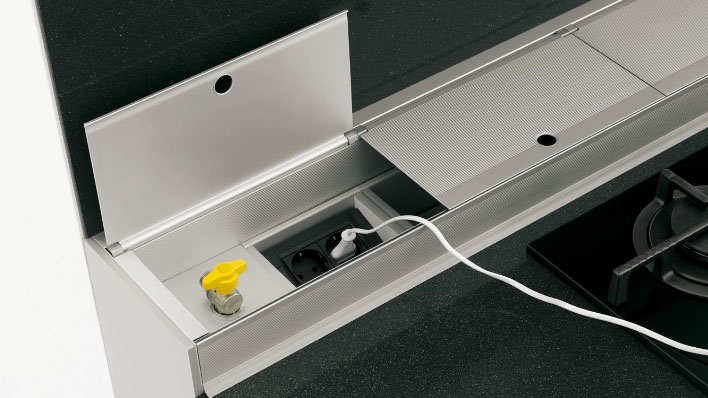
In the prepared hole mounted boxka from the wall outlet. Initially, you want to try it in place and install, is required or not to change the aperture size. After that, the holes are opened in the Box, where it is necessary to push the lead wire. The box is inserted into the wall, and the gap between the wall and a box smeared.
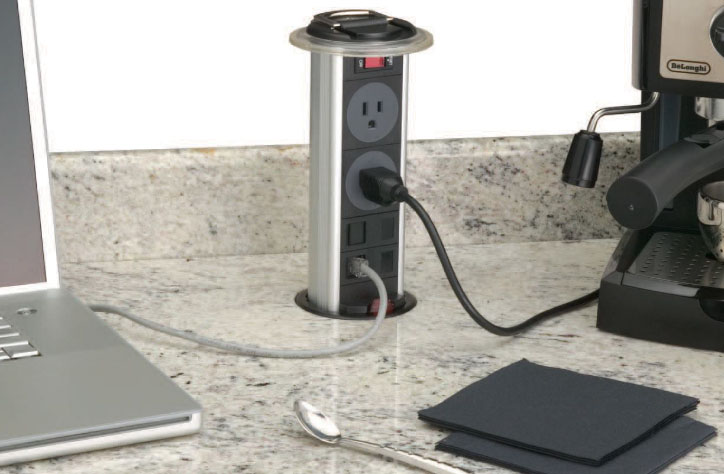
End of wire strands trimmed to one - half centimeter. If the released core consists of several or a plurality of wires, then they need to twist together.
Liberated lived secured in screw or spring clamps, mounts.
Excess wire is placed between a wall in the hole and the bottom Escutcheon. This is done carefully, avoiding excesses wire.
Escutcheon fixed in the box by means of screws arching forks or legs.
Top dressing is screwed and the base socket and the cover.

Connecting to the network scheme
Installing a wall socket - this is not the final cut power. Wire to outlet should be installed in a special channels and closed. If the gasket is in shtroblenie channels, it is desirable to lay wire in Corrugated, for extra protection.

In the lines of the most energy-intensive units need to have circuit breakers. The main power cable, from which is all the wiring in the kitchen should come into force housing panel through its own circuit breaker.
Kitchen outlet is properly grounded.

